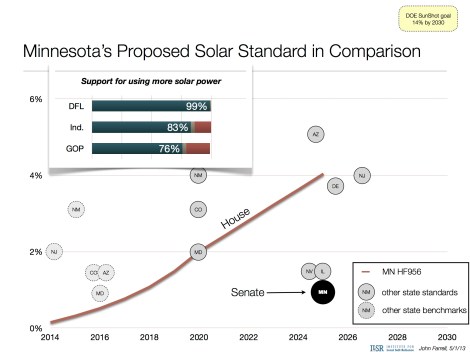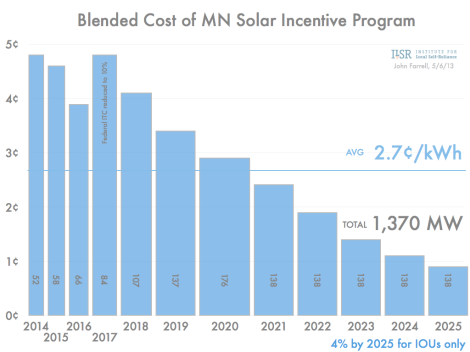Last week, a solar energy standard moved one step closer to passage in the Minnesota state legislature, with an innovative new approach to financing solar power. It’s a powerful first step for what would be one of the more robust policies to support distributed, local solar power in the country.
The policy has three key pieces, outlined below.
A Solar Standard
Following in the steps of 16 other states, the House version of the Minnesota bill sets a timeline for (investor-owned) utilities to add solar to their electricity mix:
0.5% of electricity sales by 2016
2.0% of electricity sales by 2020
4.0% of electricity sales by 2025
And, an “objective” of 10% solar by 2030
Unlike other states, this solar energy standard is not a carve-out of the existing 25% by 2025 renewable energy standard, but is in addition to that standard.
The following chart compares the proposed standard to those in force in other states:
Paying for Production: The Value of Solar (VOS) & Incentive
In addition to the standard, the legislation requires utilities to mimic the VOS calculation popularized by Austin Energy in Texas, essentially setting a market price for solar power (per kilowatt-hour) on the basis of its value to the grid. There are seven components address in the bill:
- Line loss savings from avoided electricity imports on the transmission and distribution grid
- Capacity savings from avoiding upgrades to transmission and distribution systems by providing local power
- Energy savings from reducing wholesale energy purchases
- Generation capacity savings from offsetting the need for new (peak) capacity
- Fuel price hedge value from a zero fuel cost energy source
- Environmental benefits
- Economic benefits from the growth of the state’s solar industry
For more context, this article talks more generally about the value of distributed generation to the grid and this study [pdf] gets right into the nitty gritty of Austin’s calculation.
The VOS price will be combined with a production-based incentive (PBI) to offer solar energy generators a price sufficient to provide a reasonable return on investment if their project produces energy as anticipated. This “reference price” (VOS+PBI) will be differentiated by project size:
- Residential
- Small commercial (less than 25 kilowatt (kW))
- Large commercial rooftop (25 kW to 2,000 kW)
- Large commercial ground-mounted (25 kW to 2,000 kW)
As is implied above, no project larger than 2 MW may get the VOS or PBI, but rather would seek a power purchase contract via utility request for proposal or competitive bid process.
A Standard, Long-Term Contract
Utilities must develop and use a standard contract that offers producers the combined value of solar and PBI over 20 years. This dramatically simplifies the financing and development of distributed solar power projects and will hopefully mean the solar energy standard will be met with a diversity of utility-scale and distributed solar.
Summary
If the bill can win over legislators in the House and Senate, it promises to deliver over 1,300 megawatts of solar power to Minnesota electricity users, create over 5,000 jobs and pump more than $5 billion in the state’s economy in the next decade. It also promises to be very affordable, with a forecast blended cost per kilowatt-hour (for the incentive) of just 2.7¢ per kWh.
Should it pass, the solar energy standard will be a good fit for a state where the women are strong, the men good looking, and the energy policies are above average.





